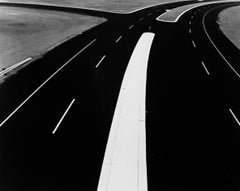Michael Gaillard
Late 20th Century Black and White Photography
Silver Gelatin
Burk Uzzle for sale on 1stDibs
Burk Uzzle was born in Raleigh, North Carolina, in 1938. His career received its first major impetus in 1962, when Life magazine hired him as the youngest ever photographer to work for them. For many years, Uzzle continued to produce work for Life as well as other publications worldwide. Some of his most notable work during this time included coverage of the Martin Luther King funeral in 1968 (Newsweek used one of his images as their cover photo that week), as well as his Woodstock work. But his photographic work went beyond photojournalism. His first book in 1971 featured his American landscape work. Later in the 70s, he began experimenting with still-life photography. In 1984, another monograph, All American, was published. Museum shows followed, including solo shows at the Chicago Art Institute in 1971, the Philadelphia Museum in 1984 and the Chrysler Museum in 1992. In 2016, Uzzle’s work was featured in triple-venue exhibitions in his home state of North Carolina, at the North Carolina Museum of Art in Raleigh at the Ackland Museum of Art, at the University of North Carolina in Chapel Hill and the Nasher Museum of Art at Duke University in Durham. Uzzle’s work is included in the holdings of many prominent museum and private collections, including the Library of Congress, the Art Institute of Chicago, the Museum of Modern Art and the Metropolitan Museum of Art in New York, the Bibliothèque Nationale in Paris and the private Margulies collection in Miami and Bidwell Projects in Ohio.
Finding the Right black-white-photography for You
There’s a lot to love about black and white photography.
The unique and timeless quality of a black and white photograph accentuates any room. Some might argue that we’re naturally drawn to color photography because it’s the world we know best. This is a shared belief, particularly in the era of camera-phone photography, editing apps and the frenetic immediacy of sharing photos on social media. But when we look at black and white photography, we experience deep, rich shadows and tonal properties in a way that transfixes us. Composition and textures are crisp and engaging. We’re immediately drawn to the subjects of vintage street photography and continue to feel the emotional impact of decades-old photojournalism. The silhouettes of mountains in black and white landscape photography are particularly pronounced, while portrait photography and the skylines of urban cityscapes come to life in monochrome prints.
When decorating with fine photography, keep in mind that some color photographs may not be suitable for every space. However, you can be more daring with black and white photos. The gray tones are classic, sophisticated and generally introduce elegance to any corner of your home, which renders black and white prints amazingly versatile.
Black and white photography adapts to its surroundings like a chameleon might. A single large-scale black and white photograph above the sofa in your living room is going to work with any furniture style, and as some homeowners and designers today are working to introduce more muted tones and neutral palettes to dining rooms and bedrooms, the integration of black and white photography — a hallmark of minimalist decor — is a particularly natural choice for such a setting.
Another advantage to bringing black and white photography into your home is that you can style walls and add depth and character without worrying about disrupting an existing color scheme. Black and white photographs actually harmonize well with accent colors such as yellow, red and green. Your provocative Memphis Group lighting and bold Pierre Paulin seating will pair nicely with the black and white fine nude photography you’ve curated over the years.
Black and white photography also complements a variety of other art. Black and white photos pair well with drawings and etchings in monochromatic hues. They can also form part of specific color schemes. For example, you can place black and white prints in colored picture frames for a pop of color. And while there are no hard and fast rules, it’s best to keep black and white prints separate from color photographs. Color prints stand out in a room more than black and white prints do. Pairing them may detract attention from your black and white photography. Instead, dedicate separate walls or spaces to each.
Once you’ve selected the photography that best fits your space, you’ll need to decide how to hang the images. If you want to hang multiple photos, it’s essential to know how to arrange wall art. A proper arrangement can significantly enhance a living space.
On 1stDibs, explore a vast collection of compelling black and white photography by artists such as Mark Shaw, Jack Mitchell (a photographer you should know), Berenice Abbott and David Yarrow.
